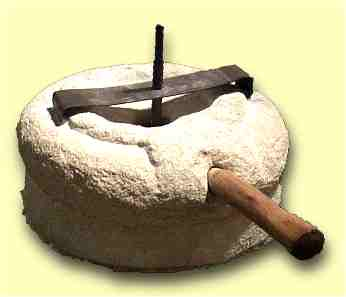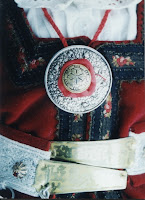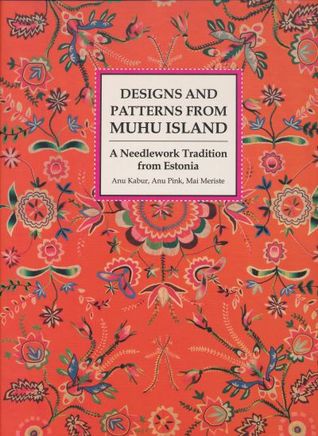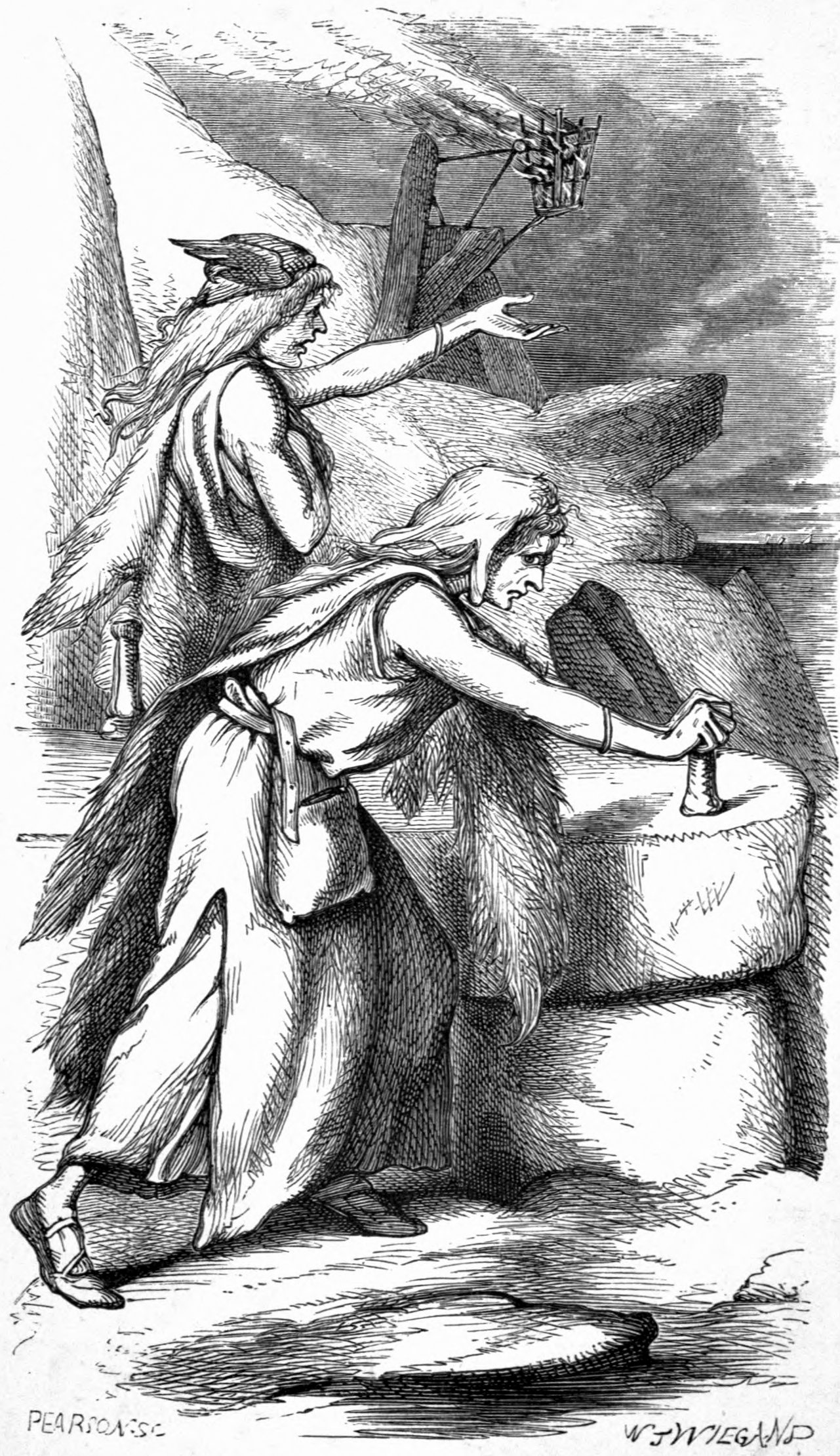"Images are just constructions, as any other human product."
In visual art as in literature, what is chosen to be depicted and how it is depicted can speak volumes about the creator of a work. So it is with the Voynich. We can pick up a substantial amount of information about who created it by looking at what they drew.
Suns and Brooches
Women in many parts of Europe would have been particularly familiar with radial, circular designs. Some of them would have worn the brooches (solde, solju, sølje, risku, sakta, kösöntyű) that are found throughout this region of the globe, from Norway to Setumaa, Estonia, where only those women could wear the big brooch who were able to give birth to a child. When a girl was wearing a heaped brooch this signified the onset of menstruation and women who were not wearing brooches anymore had already passed their menopause. As you can see, these brooches were circular and big. At least for the Sami, the risku represents the sun. Now look again at the star charts with the women in the center, with light radiating from her.
Below is an excerpt from FOREST MYTHS: A BRIEF OVERVIEW OF IDEOLOGIES BEFORE ST. STEFAN by Pavel F. Limerov:
The function of a Heavenly Mother of the female deity standing on a lizard-like animal is marked by solar symbols – it may be a circle on her forehead or an additional female mask above her head, and sometimes even a mask on her chest. The Goddess Mother may have also functioned as a solar deity, and possessed an epithet Shondi Mam ‘the Solar Mother’ (cf. the Udmurt Shundy Mumy ‘Sun-Mother’) as sun is one of the symbols of heavenly and underworld fertility.
The Sun Spiral
Related to the Mesopotamian symbol for eternity, the sun spiral, known throughout Europe--in Georgia as the Borjgali (Georgian: ბორჯღალი; also Borjgala or Borjgalo) and Armenia as the Arevakhach--is usually placed above the Tree of Life and symbolizes the Sun, eternal movement, and life. Kolovrat means spinning wheel in a number of Slavic languages and is found to be an ancient symbol of a Russian and Slavic native faith.
 |
| Star spiral from Voynich (left) and Cross with Kolovrat, Visoki Dečani monastery, XIV century (1327-1330) |
Below is a sun spiral on an engraved stone found in Havor, Gotland.
(The Art Archive/Historiska Museet Stockholm/Dagli Orti)
The stone also portrays the horses Arvakr and Alsviðr (Árvak and Alsvin), Early-Awake and Very-Swift. In Norse mythology, Sköll (Old Norse “Treachery”) is a wolf that chases the horses Árvakr and Alsviðr, that drag the chariot which contains the sun (Sól) through the sky every day, trying to eat her. Sköll has a brother, Hati, who chases Máni, the moon. At Ragnarök, both Sköll and Hati will succeed in their quests.
Below is a Voynich manuscript star chart claimed by some to be a galaxy. It is placed beside simple crochet motifs employed in Russian folk art. Russian folk art in fact goes back to the Neolithic, predating the discovery of galaxies by several centuries.
The Animals
The animals depicted in the Voynich mss. have their precedents in European handicrafts and very commonplace nature.
The Lizard of the Underworld/Fertility
Below is a lizard with seven fish in its stomach. This graphic and passages below are from: THE PERMIAN ANIMAL STYLE, Editors Mare Kõiva & Andres Kuperjanov & Väino Poikalainen & Enn Ernits, Published by the Folk Belief and Media Group of ELM http://haldjas.folklore.ee/folklore, Estonian Folklore.
"The numbers 4, 7 and 10 are significantly often also found in parts of the lizard motif and its decorations (e.g. Figures 46 and 48). I have observed a connection with fertility in the case of the lizard motif (e.g. Figures 48, 51–52). This fits to the explanation according to which lizard symbolised Earth and the under-world, the world of the dead. In Udmurtian beliefs, life was a gift from the deceased and the living received their souls from forefathers (Holmberg 1914: 51–53). When a Komi sowed a field, went hunting or fishing, he always asked the deceased for their blessing (Nalimov 1907: 10)."
...From the point of view of land, underground forces and fertility, time is the factor what makes growing possible. The numbers under discussion refer, also in connection with the lizard, to time and fertility.
 |
| Permian bronze casts like this lizard signifying the underworld were produced by the Komi and Udmurt people between the 4th and the 14th centuries. |
Below are Voynich animals. Note the resemblance of the animal below right to the lizards above.
 | ||||
Voynich animals
|
The Fish
Below we have a scene from a manuscript fairly contemporary with the Voynich:
And here is a scene from the Voynich:
What's missing?
- A blue-green monster skin
- An ugly grimace
- Horns or donkey ears
- Oh yeah, and Mr. Helmet-head ready to kill her
In the Voynich scene the woman's thighs are incontestably her own, so she's not becoming the fish. If the fish were eating her, it would probably start with the head, not the feet. Rather, it appears that the woman is emerging from the fish. Her eyes are set to what's above her, and she doesn't look wholly petrified at her situation. Where is there any trace of a cultural tradition where a woman might emerge from a fish down in a cave?
Here is the Wiki on Finnish mythology:
Tuonela was a dark and lifeless place, where the dead were in a state of eternal sleep. Shamans were sometimes able to reach the spirits of their dead ancestors by traveling to Tuonela in a state of trance created by rituals. He had to make his way over the Tuonela river by tricking the ferryman. While in Tuonela, the shaman had to be careful not to get caught: the living were not welcome there. Shamans who were caught could end up decaying in the stomach of a giant pikefish with no hope of returning to normal life. If the shaman died during the trance ritual, it was believed that he had been caught by the guards at Tuonela.
The pike is a very large, large-mouthed freshwater predator often speckled and with rounded lobes, as is depicted in the Voynich manuscript. This little shamaness could be emerging from Tuonela.
The Bird
The bird could be a stork, or a snow goose, or a grouse, or an ibis... I don't see any outstanding difference between it and hundreds of thousands of such birds sewn, painted, and carved in folk art. For millennia, the bird has been one of the most popular of such motifs.
In Russian folklore The Bird carries a lot of meanings. It symbolizes the spring, The Sun itself, and different aspects of The Sun (its warmth, light, and power). Fire essence of the Bird is reflected in fairy-tales of Firebird, and in Russian euphemism for a fire ("a red rooster"). The Bird promises a good harvest and prosperity. The Bird embodies the concept of love, marriage, and motherhood. ...Images of The Swan and The Goose on women's headdresses and costumes are caused by the worship of waterfowls in Northern Russia. Scientists believe such worship was established in Neolithic Age. Northern Russia's arts and crafts are full of Swans and Geese. Birds appear not only on clothes, but also as an element of a decoration of houses, spinning-wheels, and harnesses. More here.
And here is an excerpt from Anssi Alhonen's Notes on the Finnish Tradition:
The upper world is located in the skies and also to the south. The great birch tree (or in Finnish tradition, the giant oak) grows there. At the roots of the tree, a spring flows and marks the source of the world river. Near the tree and spring there is a warm lake, or 'sea of life', where water birds and human souls are renewed. In the Finnish folk religion this upper world became a warm and light world located in the south called Lintukoto (or 'home of the birds') and the sea of life became a body of warm water surrounding the Lintukoto.
Finnish Mythological Cosmos
The Designs
Here are some examples of European designs in handicrafts beside those in the Voynich manuscript. What becomes clear when studying the designs in the manuscript is that the artist(s) loved putting in the following:- fringes
- flowers with little circles in the middle
- birds
- intricate, contrasting abstract borders
- radial designs
and other elements familiar to the tradition of folk handicrafts.
Flower of Life Rosette
 |
| Geometrical symbols, including a "flower of life" rosette, incised on roof beams of a ceiling dating from 1681 |
"Passivity and obedience, moreover, are the very opposites of the qualities necessary to make a sustained effort in needlework. What's required are physical and mental skills, fine aesthetic judgement in colour, texture and composition; patient during long training: and assertive individuality of design (and consequence disobedience of aesthetic convention). Quiet strength need not be mistaken for useless vulnerability."
― Rozsika Parker, The Subversive Stitch: Embroidery and the Making of the Feminine
Sun Symbol
 |
| Obviously, the Finns still love big, circular sun designs. |
Baltic Octagram
 |
| The Embroidery and Knitting of Muhu Island, Estonia |
 |
| Finnish embroidery |
Embroidered Flowers
Kihnu Embroidery
"Muhu handicraft may truly be considered one of the brightest chapters in the great
treasury of Estonian folk art. At all times there have been maidens and women on this small plot of land, overgrown with junipers, who have knitted incredibly fine-textured mittens and socks they have been fond of wild color combinations, embroidered floral beauty and rather sharp-tongued humor."
Karelian Embroidery
Csanga (old Hungarian) Embroidery
Nordic sweater collars

Alternating leaves, box fringes, and radial designs

 |
| Perm, Russia |
Lace of Vologda
Vologda lace is hugely varied in its patterns, but often it begins on a lattice (left), which creates a sort of skeleton for the whole. While the Voynich map's rosettes (middle) differ from the lace sample on the right, it is structured on a grid of circles with connectors, as if on a lattice for lace-making, contrasting greatly with a typical renaissance map such as the one below.
The world tree and the quern as metaphors for the cosmos
 |
|
 |
| In various north European traditions, the quern is a metaphor for the world with the polar star its pivot or nail. |
Eldar Heide gave a paper titled "Finno-Ugric and Scandinavian notions about the world axis and the cosmic quern" on 5 April 2013 at the third meeting of the Austmarr Network, Härnösand.
It is well known that Finno-Ugric peoples, like people further east, had a notion that the polar star was a nail in the top of an invisible world pillar. It is also known that among the Baltic Finns, the mythic object Sampo seems to have been this world pillar, but also the firmament (revolving around the polar star) understood as a gigantic mill, as well as a magic hand mill that grinded out prosperity for its human owner in mythic times.Heide examines to what extent such notions were shared by the (Germanic) Scandinavian neighbours.
Norse Runes and Staves
Baking
Here is a beloved shape in Karelia: the frilled oval with a soft center.
 |
| Flower |
 |
| Hill |
 |
| Pie! |
Conclusion - Medieval/Renaissance women
as artists and writers
Especially if they were common folk, women in the 15th c. who dared to draw and write would risk trial, ostracization, and possible immolation. But let's just say for a moment that women did chance it. What they would have had to do was translate the skills they were required to have--knitting, weaving, embroidery--into skills they were not at all expected or even allowed to have: painting, cartography, botany, and writing.
Now, everything about the Voynich manuscript is odd--the penmanship, the designs, the plants, the human figures, the map, the way everything is drawn, even the containers for the herbal remedies have no precedent in the known traditions of Western Civilization, which appears to add substantial weight to the speculation that the entire thing is a hoax. It's a lark. No serious man of letters would have created this, OR rather what he really meant to record is hidden deep within what can be seen so that only those "in the know" can decipher it.
Bollocks.
The Voynich manuscript is WYSIWYG. The only mystery lies in how this gender bias can persist.














































I wanted to leave a comment and thank you for sharing this. The Voynich has always fascinated me and I've been taking a long wonderful dig through your writings about it and really appreciating your work and findings. Thank you! -- Best, Brin McLaughlin, SF CA US
ReplyDeleteYou're very welcome, Brin. So happy it speaks to you.
Delete